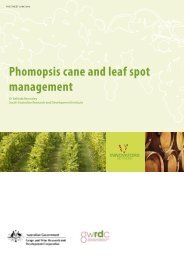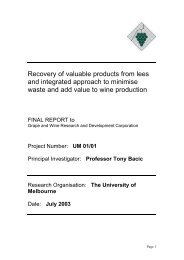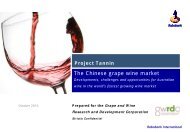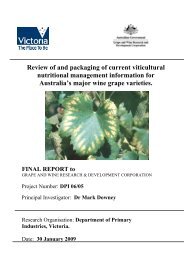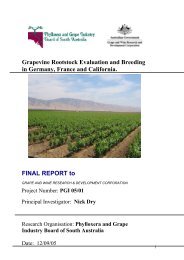Identification of the major drivers of 'phenolic' taste in ... - GWRDC
Identification of the major drivers of 'phenolic' taste in ... - GWRDC
Identification of the major drivers of 'phenolic' taste in ... - GWRDC
Create successful ePaper yourself
Turn your PDF publications into a flip-book with our unique Google optimized e-Paper software.
AWRI: <strong>Identification</strong> Of The Major Drivers Of ‘Phenolic’ Taste In White W<strong>in</strong>es<br />
Hyperoxidation (HOX-LHP): 100 L <strong>of</strong> <strong>the</strong> FR, HP or 50:50 mix <strong>of</strong> FR and HP juices were<br />
immediately sparged with 100% oxygen at 8-10 L/m<strong>in</strong> until a dissolved oxygen value <strong>of</strong><br />
approximately 40 mg/L was reached, measured us<strong>in</strong>g a Nomasense PSt3 optrode.<br />
Cold soak/maceration (MAC): destemmed and crushed must from 750 kg was held <strong>in</strong> ei<strong>the</strong>r <strong>the</strong><br />
Willmes press (2010), or a 1,000L (2011) open fermenter sealed with shr<strong>in</strong>k wrap film, with 100<br />
mg/L SO2 as PMS solution added for 60 hours at around 5°C. It <strong>the</strong>n followed a standard press cycle<br />
with comb<strong>in</strong>ation <strong>of</strong> press<strong>in</strong>gs and free run.<br />
Fermentation on sk<strong>in</strong>s (SKI): 2.5 kg <strong>of</strong> crushed grapes were added to 25 kg <strong>of</strong> FR juice.<br />
Solids fermentation (SOL): FR juice was not cold settled with pectolytic enzyme prior to<br />
fermentation.<br />
Fermentation, F<strong>in</strong><strong>in</strong>g and Bottl<strong>in</strong>g<br />
The juices were pH adjusted us<strong>in</strong>g tartaric acid or potassium carbonate, and (except<strong>in</strong>g <strong>the</strong> solids<br />
ferment treatment) were cold settled with <strong>the</strong> aid <strong>of</strong> pectolytic enzymes for 24-48 hours. They were<br />
<strong>the</strong>n divided <strong>in</strong>to 2 x 30 L fermentation vessels and <strong>in</strong>oculated with S. cereviseae stra<strong>in</strong> EC1118.<br />
Bentonite (Sodium) was added (1 g/l) to every vessel <strong>in</strong> order to achieve prote<strong>in</strong> stability. The ferment<br />
proceeded at 0.5 to 1.0 °Bé per day until dryness. Thereafter, 60 mg/L SO2 (as PMS) was added<br />
before stor<strong>in</strong>g <strong>the</strong> w<strong>in</strong>e at 0°C.<br />
20 L vessels were completely filled with <strong>the</strong> f<strong>in</strong>ished w<strong>in</strong>es under dry ice protection. Tartrate<br />
stabilisation was carried out by seed<strong>in</strong>g with 4 g/L KHT at 4°C once any necessary f<strong>in</strong>al pH/TA<br />
adjustments were made. If required, fur<strong>the</strong>r bentonite was added for prote<strong>in</strong> stabilisation at <strong>the</strong> level<br />
determ<strong>in</strong>ed by <strong>the</strong> 80°C/2 hour test with <strong>the</strong> sample pass<strong>in</strong>g if




